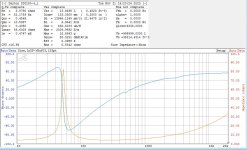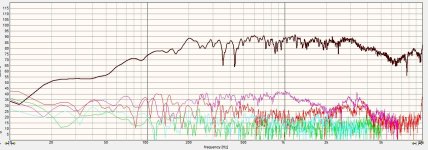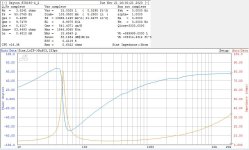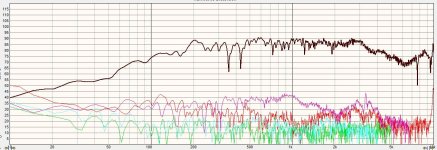They look really nice, Dayton moved to high Qm with these ones...
But I seriously doubt that perfect rol off of Sig180...
We wait for somebody to do independant measurements...
But I seriously doubt that perfect rol off of Sig180...
We wait for somebody to do independant measurements...
This forum is the most open minded and least dogmatic I know. Don't disparage it, even with 😉is not allowed here on this holy board
Finally got some retesting done, as well as some quasi-measurements.
I measured the T/S with the film off of the pole this time, so those are truly valid. Those specs did not change that much from the previous.
I also measured the woofers in a very holey box with lots of fill, surface mounted, sitting on the floor facing up. This is not quite ground plane being the box was against the 'wall', and the mic was about 30" from the woofer on axis in the leaky box. It is also not free field. This means the baffle step is partially compensated for in the measurements.
I measured the T/S with the film off of the pole this time, so those are truly valid. Those specs did not change that much from the previous.
I also measured the woofers in a very holey box with lots of fill, surface mounted, sitting on the floor facing up. This is not quite ground plane being the box was against the 'wall', and the mic was about 30" from the woofer on axis in the leaky box. It is also not free field. This means the baffle step is partially compensated for in the measurements.
Attachments
Last edited:
Trough the most important midrange flatter/more consistent than other 6.5 inchers , what more do you want , do you want more 🙂
In reality , things are much more complicated . There is baffle step and baffle diffraction . SLinkwitz once stated : At 90 degree there is no baffle step!
The IEC baffle (135x165cm) is a good compromise , often used by many .
CIARE in Italy stating it has a dip around 400Hz , in some of their data sheets where the driver is working in pistonic mode but shows a dip centered at that frequency .
In this data sheet is a wide dip but I think it has to do with the DAR surround acting like a passive-resonator because it is acousticly/mech. coupled to the nearby surround , not a good thing (could be similar in the KEF coax units with wide flat surround having little stiffness of their own) :
https://h-audio.de/images/product_images/img_lautsprecherPA/sica/z004100.jpg
The IEC baffle (135x165cm) is a good compromise , often used by many .
CIARE in Italy stating it has a dip around 400Hz , in some of their data sheets where the driver is working in pistonic mode but shows a dip centered at that frequency .
In this data sheet is a wide dip but I think it has to do with the DAR surround acting like a passive-resonator because it is acousticly/mech. coupled to the nearby surround , not a good thing (could be similar in the KEF coax units with wide flat surround having little stiffness of their own) :
https://h-audio.de/images/product_images/img_lautsprecherPA/sica/z004100.jpg
That wobbliness could be caused by something nearby that is reflecting back the waves.
Mike
AmpsLab-Spk
Mike
AmpsLab-Spk
As already stated. If all distortion is minimum 55dB down - everywhere. And the breakup is around 10kHz - for half the price of SB and others. Then it should be a pretty nice driver overall 👍
Last edited:
KEF uses both a cone that has a variable thickness and a rubber sleeve around the voice coil, to suppress the break-up frequency and move it higher up - per this video (unless you are talking about some other version - again not related to Dayton Signature):In this data sheet is a wide dip but I think it has to do with the DAR surround acting like a passive-resonator because it is acousticly/mech. coupled to the nearby surround , not a good thing (could be similar in the KEF coax units with wide flat surround having little stiffness of their own) :
https://h-audio.de/images/product_images/img_lautsprecherPA/sica/z004100.jpg
-45 to 50dB anyway, as it's not -55 in my plots. 40 and 85-90dB respectively. But yes, I see no reason to think this is a bad driver. A driver at -45dB or better across the board at thus price I'd call a steal.As already stated. If all distortion is minimum 55dB down - everywhere. And the breakup is around 10kHz - for half the price of SB and others. Then it should be a pretty nice driver overall 👍
Michael, yes, it was mainly to get an HD plot. I do not hold much stock in the FR plots I posted. They will be retaken for 2 reasons. 1- My current laptop is on its deathbed, one coming to replace it. 2- Of course they were not taken with as much caution as I normally use.
I would be most interested to know how problem-free it would be to operate the Sig225 up to 1 kHz. The distortion bump of the sig180 at 800 Hz unsettles me a little. Are there any new findings?
Kind regards,
Michael
@Blechonkel: alles so wie immer....but i like it.... 😎
Kind regards,
Michael
@Blechonkel: alles so wie immer....but i like it.... 😎
Probably because they haven't bought any yet. Dayton isn't massive on this forum (though far from unknown) -if you want more in the way of discussion on the subject, you're more likely to find it on Partsexpress's Techtalk board, since Dayton are more or less their 'house brand'.
The one drawback I see on these new Dayton drivers is a longer than typical VC former, which tends to cause standing waves inside the pole cavity. The other issue is the spider resonance, which looks to be present on most of the drivers in that series. The main deal breaker for me is the concave Alu cone. If the surround can't control the first radial mode, it will be a difficult driver to work with in terms of xover. The Dayton FR graphs are very smoothed and don't show enough resolution to quantify the potential problems in the suspension design. The larger models look somewhat promising but the price tag isn't that low.
The hellectromagnetic transducer is full of evil stuff but we like it like it like it yes we do ... (Jagger/Stones etc)
Do you know ONE driver that is free of flaws? (only one , please!)
Give us the answer please , the magic information that makes our money pockets fly 🙂
God is a good sales man plenty of stuff but that ONE thing is not offered!
Please don't make the same error twice Mr. God , and send us a doubtful profiguy 🙂
we are burning for this hobby .. no hell is hot enough for us 🙂
send all devils home here is no gain for them!
Do you know ONE driver that is free of flaws? (only one , please!)
Give us the answer please , the magic information that makes our money pockets fly 🙂
God is a good sales man plenty of stuff but that ONE thing is not offered!
Please don't make the same error twice Mr. God , and send us a doubtful profiguy 🙂
we are burning for this hobby .. no hell is hot enough for us 🙂
send all devils home here is no gain for them!
I'm still waiting to see if the reported changes between the originals & production units have actually happened or not -and if so, exactly what and why. I've seen worse, but at the moment I still lean toward the RS225-4/8 or the RS210HF if you can cope with the latter's very low sensitivity, making the 225 still the canny choice. I wish Dayton would back off a bit on the smoothing though -the old data sheets were better in that regard, even if the physical graph size was a bit small.The one drawback I see on these new Dayton drivers is a longer than typical VC former, which tends to cause standing waves inside the pole cavity. The other issue is the spider resonance, which looks to be present on most of the drivers in that series. The main deal breaker for me is the concave Alu cone. If the surround can't control the first radial mode, it will be a difficult driver to work with in terms of xover. The Dayton FR graphs are very smoothed and don't show enough resolution to quantify the potential problems in the suspension design. The larger models look somewhat promising but the price tag isn't that low.
Reported changes? Which? Underground DIY that we're not aware of?
Changes for the better I hope ....
Changes for the better I hope ....
The RS225 is hard to beat. One of the better Dayton drivers IMO aside from the PA310.
The one drawback I see on these new Dayton drivers is a longer than typical VC former, which tends to cause standing waves inside the pole cavity. The other issue is the spider resonance, which looks to be present on most of the drivers in that series. The main deal breaker for me is the concave Alu cone. If the surround can't control the first radial mode, it will be a difficult driver to work with in terms of xover. The Dayton FR graphs are very smoothed and don't show enough resolution to quantify the potential problems in the suspension design. The larger models look somewhat promising but the price tag isn't that low.
The clue I look at is the zoomed impedance graph. So my guesstimate is this driver should be smooth til about- 2KHz.
But like any hard cone driver, the off axis responses will most instructional. So in combination with typical directivity of a concave piston with a diameter of ~6.5” I’d cross over around 1.5 KHz.
- Home
- Loudspeakers
- Multi-Way
- Dayton Audio Sig series





